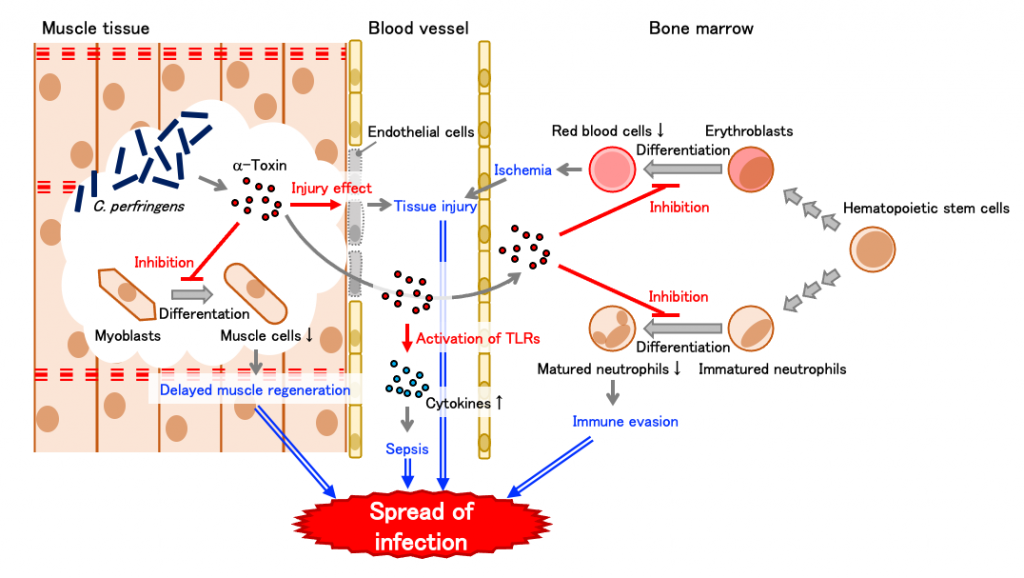Staff
Prof. Dr. Masahiro Nagahama
Dr. Keiko Kobayashi
Dr. Masaya Takehara
Research project
Research of our group is focused on the study of the pathogenic mechanism of virulence factors (toxins and enzymes) from bacterias. These proteins play critical roles in infectious diseases, often in the earliest stages of interaction between pathogenic bacteria and the host organism. Current studies focus on toxins produced by mainly Clostridium perfringens and Bacillus cereus. They are multifunctional proteins and exhibit the ability to affect cellular processes by membrane disruption, pore-dependent cytotoxicity and modification of intracellular target proteins. Through studying such toxins, we expect to better understand the molecular events that contribute to disease and to develop therapeutic inhibitors that will be used to treat disease.
- Molecular basis of toxicity of Clostridium perfringens toxins.
- Molecular mechanism of action and role in gas gangrene of alpha-toxin.
- Pore-forming mechanisms of beta-toxin and epsilon-toxin.
- Global functional analysis of cellular responses to toxins.
- Prevention of toxin-induced disease.
- Molecular mechanisms of avoidance from host immunity.
Publications
- Nagahama M, Kobayashi K, Takehara M. Cathepsin release from lysosomes promotes endocytosis of Clostridium perfringens iota-toxin. Toxins 13, 721 (2021)
- Nagahama M, Kobayashi K, Ochi S, Takehara M. Internalization of Clostridium botulinumC2 toxin is regulated by cathepsin B released from lysosomes. Toxins 13, 272 (2021)
- Takehara M, Kobayashi K, Nagahama M. Toll-like receptor 4 protects against Clostridium perfringensinfection in mice. Front Cell Infect Microbiol 11, 633440 (2021)
- Takehara M, Kobayashi K, Nagahama M. Clostridium perfringensalpha-toxin inhibits myogenic differentiation of C2C12 myoblasts. Anaerobe65, 102265 (2020)
- Takehara M, Bandou H, Kobayashi K, Nagahama M. Clostridium perfringensalpha-toxin specifically induces endothelial cell death by promoting ceramide-mediated apoptosis. Anaerobe65, 102262 (2020)
- Nagahama M, Seike S, Ochi S, Kobayashi K, Takehara M. Clostridium perfringensepsilon-toxin impairs the barrier function in MDCK cell monolayers in a Ca2+-dependent manner. Toxins12, 286 (2020)
- Takehara M, Sonobe Y, Bandou H, Kobayashi K, Nagahama M. Granulocyte colony-stimulating factor does not influence Clostridium perfringensalpha-toxin-induced myonecrosis in mice. Toxins11, 509 (2019)
- Nagahama M, Takehara M, Rood JI, Histotoxic Clostridial infection. Microbiology Spectrum6, doi: 10.1128/microbiolspec. (2019)
- Seike S, Takehara M, Kobayashi K, Nagahama M. Clostridium perfringensdelta-toxin damages the mouse small intestine. Toxins 11, 232 (2019)
- Takehara M, Seike S, Sonobe Y, Bandou H, Yokoyama S, Takagishi T, Miyamoto K, Kobayashi K, Nagahama M. Clostridium perfringensalpha-toxin impairs granulocyte colony-stimulating factor receptor-mediated granulocyte production while triggering septic shock. Communication Biology2, 45 (2019)

